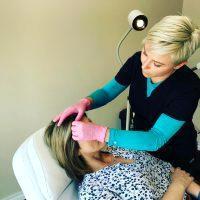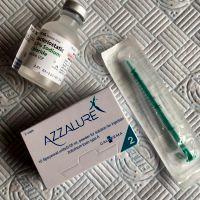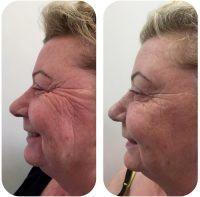Best Treatment For Crow’s Feet Around Eyes
Non-surgical options to manage crow’s feet?
Botox is an excellent choice with a long successful track record treating the concerns you expressed.
However like many situations we are faced with good long term solutions are best achieved by the addition of complimentary treatments to “bolster” the effect of the one treatment.
In this situation addition of Ultherapy, lasers, microneedle/PRP to increase collagen production can give very nice results.
However best if you present for an in person consultation to a surgeon versed in the surgical and non-surgical methods to address your stated concerns. (Paul Pietro, MD, Greenville Physician)
The crow’s feet lines are best treated with botox. Botox can relax the muscles around the eye which allows the skin to smooth.

Clusters Of Tiny Wrinkles And Fine Lines
You could also consider options to tighten the eyelid skin with radiofrequency or laser treatments. (Tarek M. Fakhouri, MD, Houston Dermatologic Surgeon)
There are numerous non-surgical approaches that can diminish crows feet lines.
One of the most common procedures involves neuromodulator (Botox/Dysport/Xeomin) typically 3 times per year. In some instances, we can use very soft, superficial hyaluronic acid filler to filler the individual lines.
Such technique can potentially induce greater longevity vs. neuromodulators. Furthermore, lasers (fractional resurfacing especially) and tightening devices (such as ultherapy) can also diminish such lines and induce tightening. (Andrei Metelitsa, MD, FRCPC, FAAD, Calgary Dermatologic Surgeon)
Botox would be great for that area. The Botox will relax that muscle for about 3-4 months.
It usually will take about a week before you see the difference. It is best to see a Board Certified Plastic Surgeon to perform this procedure.

Crow’s Feet Appear When The Skin Loses Collagen
This is usually done in the office and will only take about 5-10 minutes. This is a great non-surgical treatment. (Leo Lapuerta, MD, Houston Plastic Surgeon)
Improving Crow’s Feet with Botox/Dysport/Xeomin, lasers, microneedling/prp, ultherapy/rf treatments
A combination approach with Botox and lasers, microneedling/prp, ultherapy/rf treatments would give the most improvement.
I recommend getting a formal evaluation with a cosmetic dermatologist. (Jason Emer, MD, Los Angeles Dermatologic Surgeon)
Botox is a good procedure for crows feet lines but if you have too much redundant skin on your eyelids, surgery may be the best option.
Since Botox is remarkably easy to undergo, you may want to first see if the results with Botox are sufficient since they are so quick and relatively inexpensive. (Pamela Stuart, MD, San Jose Physician)

Crow’s-feet Develop With Age, Usually Starting In The Mid- To Late-30s
Botox and Ultherapy to lift brow and decrease crows feet
Botox is a good treatment for “crows feet”. Botox will relax the muscle in this area so you can’t make the movement that is creating the wrinkle.
Ultherapy brow lift can also help lift the eyebrows. The combination of these two treatments is an alternative to surgery and will not have a surgical outcome. However, if surgery is not for you, consult with a board certified facial plastic surgeon to see if you are a candidate for these two treatments. (James Chan, MD, Portland Facial Plastic Surgeon)
Botox or Ultherapy to lift your lateral brow
I think eyelid surgery (blepharoplasty) could be a good option, but if you prefer not to go that route, you can still get a really nice improvement by using Botox or Ultherapy. Botox can be used to elevate the tail of the brow temporarily (usually 4 months), but it is very safe and works quite well.

Crow’s-feet, Also Known As Laugh Lines And Character Lines
That would be my first option. Alternatively, Ultherapy uses microfocused ultrasound to tighten the fascia below the skin and can give you a result lasting for years.
My advice is to consult with someone who has an array of experience including surgical experience for blepharoplasty as well as devices such as radiofrequency or Ultherapy. (Michael H. Swann, MD, Springfield Dermatologic Surgeon)
Botox or Dysport will help to paralyze/relax those lateral fibers of the muscle so that when you smile, it won’t create the bunching and lines.
Depending on your areas of concern, you may also want to consider treatment at the glabella and forehead to create a “chemical brow lift.”
This treatment can help relax some of the brow depressors in your face and create a modest lifting of the brow. As always, consult with an experienced injector to discuss your specific concerns. (Steven H. Williams, MD, San Francisco Plastic Surgeon)

Different Options For Treating Crow’s Feet And Fine Lines
Botox would help soften the crow’s feet as well as open up your eyes and give you a 1-3 mm eyebrow raise. As always, see an experience injector for a detailed in person consultation. (Shaun Patel, MD, Miami Physician)
Crow’s feet treatment options
Botox is effective for treating dynamic smile lines at the eye corners (“Crow’s feet”) with the typical initial dosing of 12 units per side. Other non-surgical options for treating Crow’s feet and mild lateral brow hooding include a brow lift with filler (Bellafill gives a 5+ year result) or brow lift using Silhouette InstaLift. (Roby F. Hayes, MD, Portland Physician)
Botox or Dysport would be a simple way to decrease the lines. If you keep up with the treatment, over time these lines will be significantly less. Remember that along with our expressions , exposure to the sun causes more wrinkles.
Use a sun screen with SPF 30 , zinc and titanium. Apply the sunscreen several times if you are outdoors and when you are driving. (Christine Eros, MD, San Diego Family Physician)
The simplest methods with least side effects would include Botox or Dysport placed into the orbicular muscle. Then chemical peels with a quick recovery and minimal downtime to tighten the skin. Finally, daily skin care to prevent additional sun damage and get healthier skin. (Aldo Guerra, MD, Scottsdale Plastic Surgeon)
Botox or Xeomin in the lateral aspect of your of your eye is an easy treatment for this issue. Typically for females you will need between 8 and 12 units per eye. This produces a subtle change with eye expression and aids in reducing the wrinkle lines in the area. (Kristin J. Tarbet, MD, FACS, Bellevue Oculoplastic Surgeon)
Botox is a purified protein that relaxes the muscles around the eyes, and helps to smooth these wrinkles and ‘bunching’. Be sure to consult with a board certified injector for a full evaluation. (David Gilpin, MD, Nashville Facial Plastic Surgeon)
Bunching around the eyes
I recommend several things. The first would be to place botox around the eyes. I usually use 7.5 units on each side. This will also raise the eyebrows slightly contributing to less skin bunching.
I would also add microneedling along with a collagen-building skin product. My favorite at this point is TNS essential serum from SkinMedica, but there are many others out there. (Sarah Saxon, MD, Austin Facial Plastic Surgeon)
Bunching up at corner of eye
Since this occurs when you smile, it is dynamic and therefore the best treatment is Botox. make sure the doctor is experienced in its use. (Melvin Elson, MD, Nashville Dermatologist)
Bunching and smile lines
In my experience you are an excellent candidate for Botox. When stategically placed, Botox can stop the bunching and help to raise the brow slightly so that the skin does not over hang in the corner quite as much. (Jessica Lattman, MD, New York Oculoplastic Surgeon)
Botox and filler and laser
Botox will help prevent the bunching up. A soft filler such as Beletero, Vobella, and others can help with volume loss in your lateral aspect of your eyes which can make the ” bunch up ” deeper.
I would also suggest laser around the eye to thicken the skin with collegen stimulation . (Erik Suh, MD, Bellevue Family Physician)
